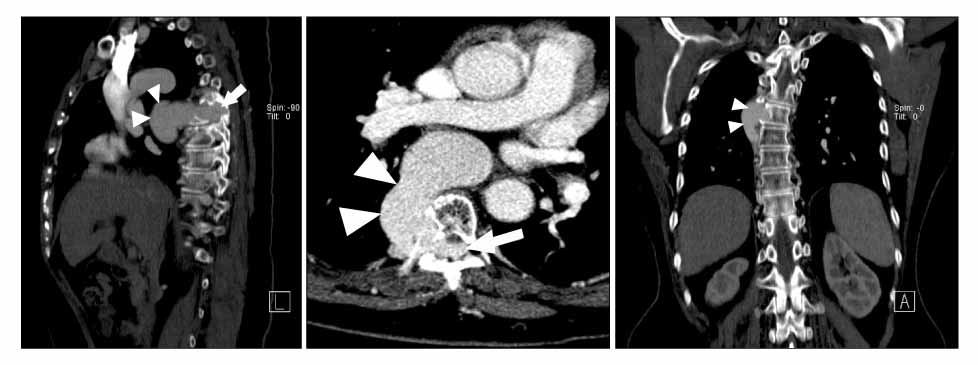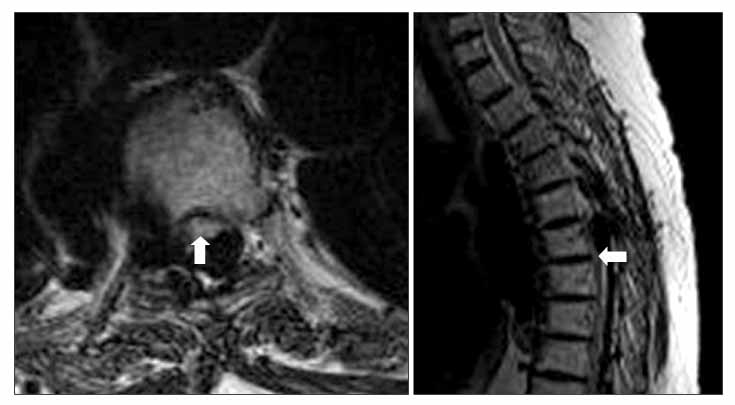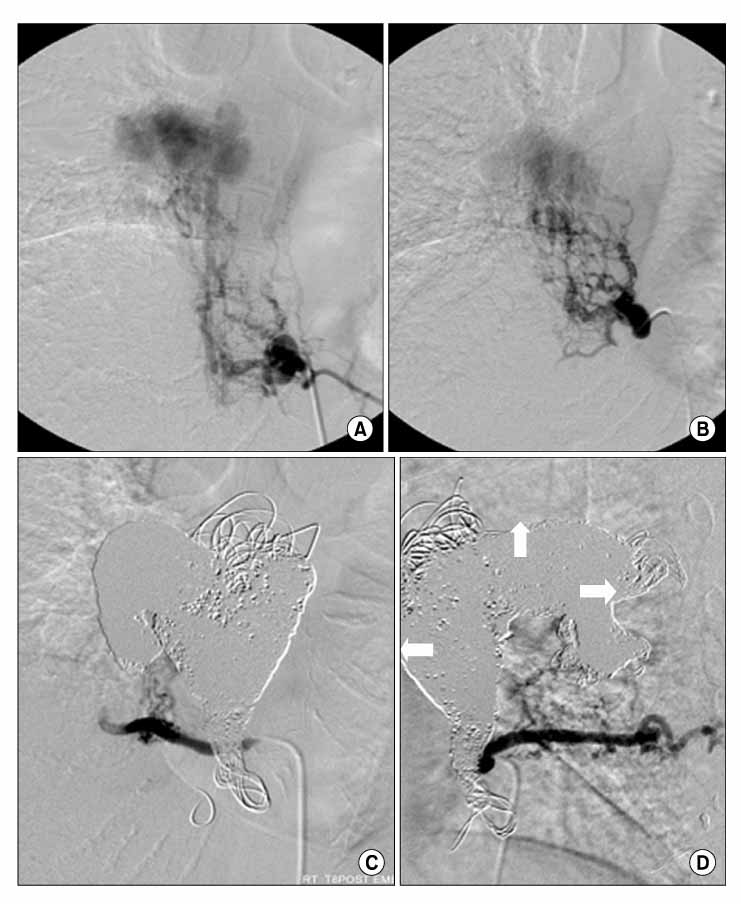J Korean Orthop Assoc.
2009 Apr;44(2):261-265.
Giant Thoracic Spinal Arteriovenous Fistula with Cord Compression: A Case Report
- Affiliations
-
- 1Department of Orthopedic Surgery, Inha University College of Medicine, Incheon, Korea. chokj@inha.ac.kr
Abstract
- A spinal arteriovenous fistula is a rare vascular disease that is characterized by abnormal connections between the vertebral artery or its branches and the neighboring veins. Bruit and back pain are common symptoms related to the fistula. Spinal cord dysfunction can also occur as a result of blood flow steal, venous hypertension, or mechanical compression of the nerve roots and spinal cord. We report a huge arteriovenous fistula in the spinal canal at the thoracic vertebra, which was characterized by a large azygous vein connected to the epidural vein causing osteolysis on the vertebral body and spinal cord compression symptoms. Staged embolization was performed using 80 coils.
MeSH Terms
Figure
Reference
-
1. Anegawa S, Hayashi T, Torigoe R, et al. Symptomatic arteriovenous fistula in a patient with neurofibromatosis type I. No Shinkei Geka. 1997. 25:373–378.2. Criscuolo GR, Oldfield EH, Doppman JL. Reversible acute and subacute myelopathy in patients with dural arteriovenous fistulas. Foix-Alajouanine syndrome reconsidered. J Neurosurg. 1989. 70:354–359.3. Hauck EF, Nauta HJ. Spontaneous spinal epidural arteriovenous fistulae in neurofibromatosis type-1. Surg Neurol. 2006. 66:215–221.
Article4. Kataoka H, Miyamoto S, Nagata I, Ueba T, Hashimoto N. Venous congestion is a major cause of neurological deterioration in spinal arteriovenous malformations. Neurosurgery. 2001. 48:1224–1230.
Article5. Inci S, Akdemir P, Ozgen T. Spinal dural arteriovenous fistula and venous aneurysm: an unusual association. Surg Neurol. 2003. 60:334–338.
Article6. Madoz A, Desal H, Auffray-Calvier E, et al. Vertebrovertebral arteriovenous fistula diagnosis and treatment: report of 8 cases and review of the literature. J Neuroradiol. 2006. 33:319–327.7. Nagashima C, Iwasaki T, Kawanuma S, Sakaguchi A, Kamisasa A, Suzuki K. Traumatic arteriovenous fistula of the vertebral artery with spinal cord symptoms. Case report. J Neurosurg. 1977. 46:681–687.8. Reddy M, Schöggl A, Saringer W, Reddy B, Matula C. Traumatic arteriovenous fistula of the vertebral artery. Neurol Med Chir (Tokyo). 2002. 42:289–292.9. Schievink WI, Piepgras DG. Cervical vertebral artery aneurysms and arteriovenous fistulae in neurofibromatosis type 1: case reports. Neurosurgery. 1991. 29:760–765.
Article10. Spetzler RF, Detwiler PW, Riina HA, Porter RW. Modified classification of spinal cord vascular lesions. J Neurosurg. 2002. 96:Suppl 2. S145–S156.
Article
- Full Text Links
- Actions
-
Cited
- CITED
-
- Close
- Share
- Similar articles
-
- Endovascular Treatment for Spontaneous Vertebral Arteriovenous Fistula in Neurofibromatosis Type 1: A Case Report
- Successful Treatment of a Spinal Intradural Arteriovenous Fistula
- Surgical Treatment of Intradural Perimedullary Arteriovenous Fistula (Type IV Spinal Cord Arteriovenous Malformation)
- Syringomyelia Associated with Spinal Dural Arteriovenous Fistula: Clinical and Radiological Improvement after Embolization
- Myelopathy Caused by Spinal Dural Arterio-Venous Fistula after First Lumbar Vertebral Body Fracture: A Case Report




